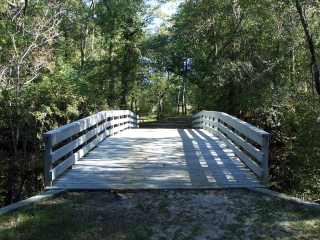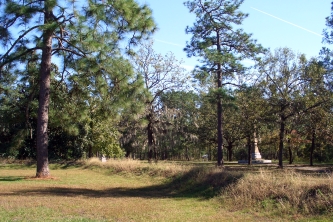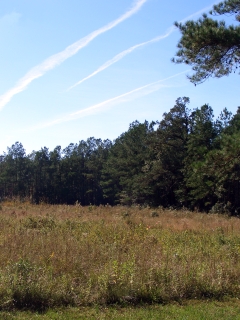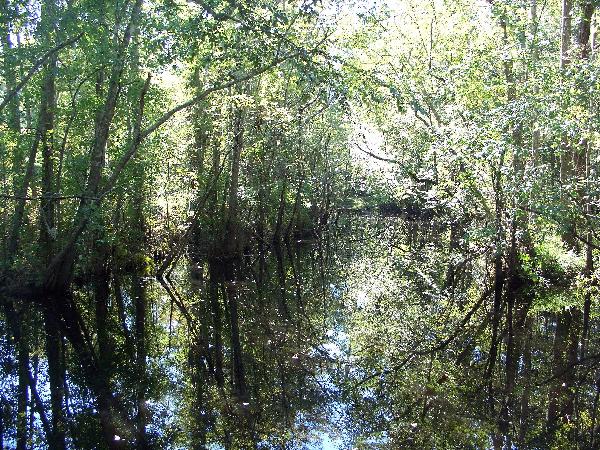NPS Website; Local Website
WHAT IS IT?
 Site of a February 27, 1776 Revolutionary War battle that preceded the signing of the Declaration of Independence by more than three months. The Patriot victory ended British authority in the North Carolina colony.
Site of a February 27, 1776 Revolutionary War battle that preceded the signing of the Declaration of Independence by more than three months. The Patriot victory ended British authority in the North Carolina colony.BEAUTY (4/10)
Two trails lead through Moores Creek NB’s 80+ acres. The Tar Heel Trail takes you amid soaring longleaf pine trees that are used in the creation of tar and turpentine, North Carolina’s primary economic source in Revolutionary times, hence the Tar Heel State.
The History Trail weaves through reconstructed Patriot Earthworks and to the infamous Moores Creek Bridge. The creek is mildly swampy and surprisingly narrow. Why exactly did the Loyalists have to cross here and here alone? The remainder of the History Trail passes Monuments that remember the Loyalists, Patriots and the first President of the Moores Creek Monument Association.
HISTORICAL INTEREST (5/10)
In the winter of 1775-76, both the Carolinas and the South, in general, were undecided in revolutionary spirit. A few were vehement American patriots and some were loyal to the Crown. Most were waiting to see which side would be successful first; the Carolinians were very pragmatic. Who would have guessed?
Eager unresolved eyes watched when, in February 1776, a regiment of 1,600 Loyalists marched across Carolina towards the port town of Wilmington and a rendezvous with British warships. The English knew the South’s ambivalence and believed if they conquered the Carolinas they would suppress the rebellion began in Massachusetts the previous April.
The Loyalist’s march necessitated a bridge crossing at Moores Creek, 20 miles to the north of Wilmington. 1,000 Patriots understood the Redcoats’ route and raced to be the first to Moores Creek. The Patriots got there first.
 With the Loyalists camped just a few miles away, the Patriots dismantled the bridge and greased the girders. Nature smiled on the Patriots. That morning, a thick fog masked the trap. Loyalist after Loyalist fell into the water ambushed by rifle fire. 70 Loyalists were killed or wounded while the Patriots lost only one man.
With the Loyalists camped just a few miles away, the Patriots dismantled the bridge and greased the girders. Nature smiled on the Patriots. That morning, a thick fog masked the trap. Loyalist after Loyalist fell into the water ambushed by rifle fire. 70 Loyalists were killed or wounded while the Patriots lost only one man.Their decisive victory brought a wave of patriotism to the Carolinas. Loyalist property was seized en masse and the British sympathizers were banished to Canada. The British invasion was stopped before it even began. Just three months later, the North Carolina delegation at the Continental Congress became the first colony to vote for Independence from Britain.
CROWDS (6/10)
We were the only people there.
EASE OF USE/ACCESS (2/5)
We are still unclear why all 1770’s roads to Wilmington passed through this part of the turpentine woods. If you visit this remote Tar Heel hamlet, you will be confused too. The Port of Wilmington has not moved but its sprawl is inching closer to Moores Creek every day. If you are coming from Port City, take U.S. Route 421 north for about 20 miles until you reach North Carolina Route 210. Turn left (west) onto 210 and the Battlefield should appear on your left in about three miles.
From Interstate 40, take Exit 408 (Rocky Point). You should be on NC 210. Take 210 west for about 15 miles and you should see the NPS facility. You could probably reach the Park Site in a quicker fashion using unmarked back roads. We tried this option, however, and got lost.
CONCESSIONS/BOOKSTORE (3/5)
The Visitor Center is currently under construction so a teaching trailer currently houses the bookstore. The good if not overwhelming selection of Revolutionary texts contains more books about other Carolina battles than Moores Creek. But really, how much can you say about such a short fight?
COSTS (4/5)
 It is free.
It is free.RANGER/GUIDE TO TOURIST RATIO (4/5)
The Ranger on duty in the trailer seemed startled by us. Is visitor traffic at Moores Creek that slow? Another Ranger mulled around in a side office poised to help. We think. Neither helped us understand the pre-Declaration of Independence fight that well but heck, there were two of them and two of us.
TOURS/CLASSES (3/10)
We two Pennsylvania travelers had no idea a Revolutionary War battle occurred in North Carolina months before the colonies formally seceded. We had only a vague idea that the Southern colonies experienced any of the War. Everything we learned at Moores Creek was new and a shock to our historical reference points.
The 30-year old cartoon film and the confusing Ranger were a poor introduction. We began to sort things out via the Park brochure and the History Trail’s wayside exhibits but achieved a better understanding only after visiting Carolina’s other Revolutionary War sites. In the meantime, our chronology and perspective were a bit off.
FUN (4/10)
The story of Moores Creek reads more like fraternity prank than a War. The Patriot men greased a bridge, wore kilts and saw only one casualty. The story also presents a villainous opposition, the Loyalists, true to the Crown and downright un-American.
After spending the previous week trolling Virginia Civil War battlefields where deaths numbered in the hundreds of thousands, a fight where only 40 died (Loyalists, even) feels almost light-hearted and fun. The good guys won, too.
 WOULD WE RECOMMEND? (3/10)
WOULD WE RECOMMEND? (3/10)Before our trip, the Wilmington, N.C. area elicited thoughts of the venerable WB Network show Dawson’s Creek and the twice-made horror film Cape Fear, not a decisive Revolutionary War battle. We assumed Moores Creek (and four other Carolina sites) honored Civil War battles. We were off by almost 100 years.
Nonetheless, Moores Creek NB was the least remarkable of the Revolutionary War sites and recommended only to the most hardcore Patriot historian. The knowledge that the battle happened is good enough for us; we did not need to see the famous bridge, now reconstructed and crossable.
TOTAL 38/80
www.usa-c2c.com
© 2005-06